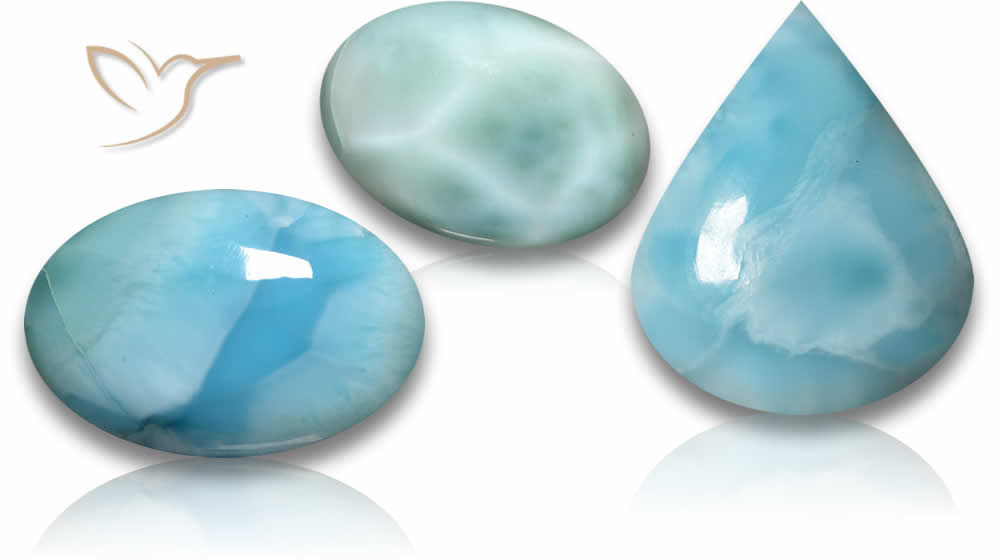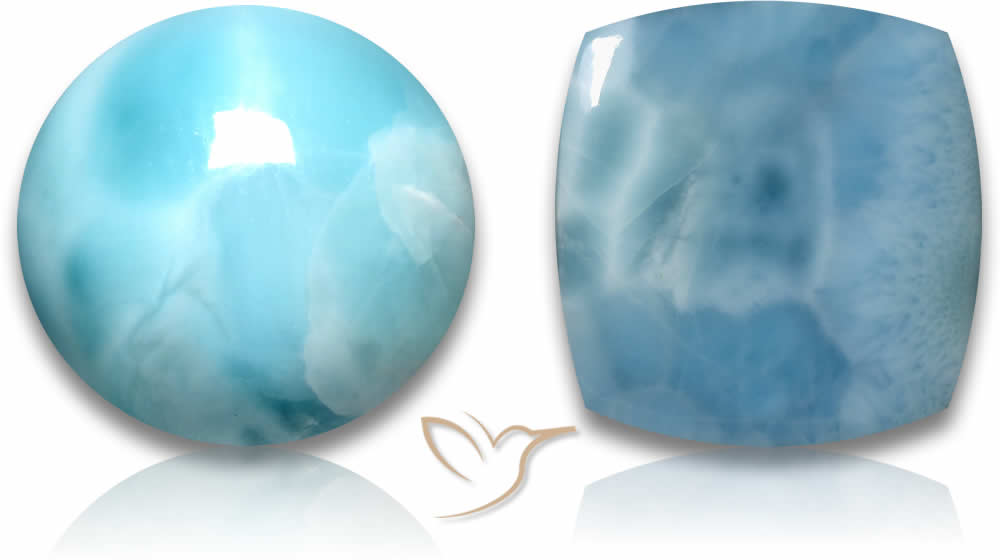Discover the Wonders of Pectolite/Larimar - Expert Insights

Join us as we embark on a journey to unravel the beauty, history, and versatility of Pectolite gemstone. Pectolite is a mesmerizing gemstone that has a close connection with larimar, a popular gemstone found only in the Dominican Republic.
Pectolite is an intriguing mineral that has captured the attention of gemstone enthusiasts worldwide with its unique features and properties. It exhibits a range of colors, including white, gray, blue, green, and brown. It has a translucent to opaque appearance and a vitreous to silky luster. Pectolite gemstones are available in various cuts and shapes, making it a versatile choice for jewelry design.
In this article, we will explore the fascinating history and cultural significance of Pectolite gemstone, uncover its mining locations, and provide essential gem care tips. We will also showcase some creative jewelry design ideas that highlight the unique beauty of Pectolite gemstones.
Join us as we delve into the mysteries and wonders of Pectolite - a gemstone that is sure to captivate your heart and soul.
Key Takeaways
- Pectolite is a captivating gemstone that is closely connected to the larimar gemstone found in the Dominican Republic.
- Pectolite gemstones come in a range of colors, with a unique appearance and silky luster.
- There are various cuts and shapes available for Pectolite, making it a versatile choice for jewelry design.
- Pectolite has a rich history and cultural significance in various parts of the world.
- Gem care is essential to ensure the longevity of Pectolite gemstones.
Uncovering the Beauty of Pectolite
Pectolite is a fascinating gemstone that exhibits a wide array of colors, making it a versatile choice for jewelry design. Its unique clarity and luster make it stand out from other gemstones, while its variety of cuts and shapes offer endless possibilities for creative expression.
The colors of Pectolite range from pale blue and white to deep blue-green and can even feature brown and gray hues. The majestic blue-green Larimar gemstone is an exceptional example of Pectolite's captivating colors, found only in the Dominican Republic.
Pectolite's clarity and luster are remarkable, featuring a glass-like transparency and vitreous shine. It is essential to pay attention to the quality of Pectolite when buying gemstones, as inclusions and fractures can have a significant impact on its appearance and value.
The choice of cut and shape can also make a significant impact on Pectolite's beauty, bringing out its unique features and characteristics. Popular cuts for Pectolite include the traditional round and oval shapes, as well as more unusual cuts such as the heart, pear, and marquise.
When caring for Pectolite gemstones, it is crucial to avoid exposing them to harsh chemicals and extreme temperatures. It is best to clean them using a soft cloth and mild soap and store them separately from other gemstones to prevent scratches and damage.
Tracing the History of Pectolite
Pectolite has a fascinating history that dates back to the early 20th century when it was first discovered in the Dominican Republic. The gemstone was initially confused with blue pectolite, another mineral with similar properties but distinct differences that were later discovered.
However, Pectolite's real claim to fame came in the 1970s when a single deposit of the mineral was found in the Los Chupaderos area in the Barahona Province of the Dominican Republic, popularly known as the Larimar deposit. This deposit gave rise to the Larimar gemstone, a unique blue-green variety of Pectolite with stunning patterns and variations.
According to local lore, the name Larimar was coined by Miguel Méndez, a Dominican who named the gemstone after his daughter Larissa and the Spanish word for the sea, "mar," because of the gemstone's ocean-like coloring. Today, Larimar is widely recognized as the national stone of the Dominican Republic, and its unique beauty and scarcity have earned it global fame.

A Symbol of Love and Connection
Pectolite is not just another mineral, but a symbol of love and connection between humans and nature. It has mythological and spiritual significance in different cultures, believed to have healing powers and promote emotional balance.
"Larimar is associated with the fifth chakra, which represents communication,", "It helps to enhance clarity of communication and encourage emotional healing."
Today, Pectolite is a highly sought-after gemstone used in jewelry design and art. Its unique patterns and colors make it a favorite among collectors, and its metaphysical properties continue to attract a growing tribe of gemstone enthusiasts worldwide.
Mining Locations of Pectolite
Pectolite is a relatively rare mineral and is only found in a few locations around the world. The most prominent mining location for gem-quality Pectolite is the Dominican Republic, where the blue Pectolite variety, Larimar, is mined.
| Location | Description |
|---|---|
| Dominican Republic | Known for its prized blue Pectolite variety, Larimar, which is found only in this location. |
| United States | Small quantities of Pectolite have been found in various states like California, Colorado, and Wyoming, among others. |
| Canada | Pectolite has been mined in Canada, primarily in Quebec and Ontario. |
| Italy | There are small deposits of Pectolite found in Italy, primarily in the Liguria and Tuscany regions. |
| Bahamas | Pectolite has been discovered in small quantities in the Bahamas. |
These locations provide an insight into the regional geological processes and conditions that led to Pectolite's formation. The quality and quantity of Pectolite found in each location vary, and this scarcity of the gemstone contributes to its value.
The Versatility of Pectolite - Jewelry Design Ideas
The unique beauty and properties of Pectolite gems make them ideal for creating exquisite and versatile jewelry pieces. From rings and necklaces to bracelets and earrings, the possibilities are endless.
Pectolite Rings
Pectolite rings are a popular choice due to the gem's soothing blue hues and durability. One design idea is to feature a larimar gemstone set in silver or white gold, creating a striking contrast that accentuates the stone's playful patterns. Another option is to design a ring that incorporates multiple Pectolite gems of different colors and shapes, creating a unique and layered look.
Pectolite Necklaces
Pectolite necklaces come in a wide range of designs, from simple and elegant to intricate and bold. One design idea is to create a simple pendant necklace that features a single Pectolite gemstone, combining it with other gemstones such as smoky quartz or garnet to create a colorful and eclectic look. Another option is to design a longer necklace that incorporates multiple Pectolite gems of varying colors and sizes.
Pectolite Bracelets
When it comes to designing Pectolite bracelets, there are many possibilities to explore. A simple and elegant design features a single Pectolite gemstone set in silver or gold, while a more elaborate design incorporates multiple beads of Pectolite in varying colors and shapes. One option is to create a bracelet that features alternating Pectolite and turquoise beads, creating a serene and calming effect.
Pectolite Earrings
Pectolite earrings are a statement piece that can add an unmatched elegance to any outfit. One design idea is to use small Pectolite beads as part of a dangle earring alongside other gemstones, creating a sophisticated and textured look. Another option is to create a drop earring that features a single larger Pectolite gemstone, drawing the eye and capturing attention.
Pectolite Jewelry Design Ideas
| Jewelry Piece | Design Idea |
|---|---|
| Rings | Feature a single larimar gemstone set in silver or white gold, or incorporate multiple Pectolite gems of different colors and shapes |
| Necklaces | Create a simple pendant necklace that features a single Pectolite gemstone, or design a longer necklace that incorporates multiple Pectolite gems of varying colors and sizes |
| Bracelets | Feature a single Pectolite gemstone set in silver or gold, or create a bracelet that incorporates multiple beads of Pectolite in varying colors and shapes |
| Earrings | Use small Pectolite beads as part of a dangle earring alongside other gemstones, or create a drop earring that features a single larger Pectolite gemstone |
With its unique and captivating features, Pectolite is a versatile gemstone that offers a wealth of design options for jewelry enthusiasts. Whether a simple ring or an elaborate necklace, Pectolite jewelry is sure to make a statement.
Conclusion
Our exploration of Pectolite has illuminated its unique features and properties that make it a beloved gemstone. As with any gemstone, Pectolite requires careful handling to ensure its longevity. Pectolite is not known to be treated or enhanced in any way.
Pectolite has a hardness of 4.5 to 5 on the Mohs scale, making it a relatively soft gemstone. It is important to handle Pectolite with care to avoid chipping or scratching. In addition to its aesthetic appeal, many people believe that Pectolite possesses healing powers. It is reputed to promote relaxation, reduce stress, and enhance communication skills.
We hope that our discussion of Pectolite has shed light on this enigmatic gemstone and inspired you to explore its beauty and versatility. Whether you choose to wear it in jewelry or simply admire it for its natural wonder, Pectolite is a gemstone that is sure to captivate and delight.
FAQ
What is Pectolite?
Pectolite is a mineral that belongs to the silicate group. It is known for its stunning blue variety called larimar, which is highly prized in jewelry.
What are the colors of Pectolite?
Pectolite can occur in a range of colors, including blue, green, white, gray, and even pink. However, the most sought-after color is the vibrant blue seen in larimar gemstones.
What is the clarity and luster of Pectolite?
Pectolite can range from transparent to translucent, with a vitreous to pearly luster. The clarity and luster can vary depending on the specific gemstone.
What are the available cuts and shapes of Pectolite gemstones?
Pectolite gemstones are commonly cut into various shapes including cabochons, beads, faceted stones, and even carved into unique shapes. The cut choice depends on the jewelry design and the desired effect.
How should I care for Pectolite gemstone jewelry?
To care for Pectolite gemstone jewelry, it is recommended to avoid exposure to harsh chemicals and cleaning agents. Clean the gemstone using a soft cloth to maintain its luster, and store it in a separate pouch or compartment to prevent scratches.
Can you provide information about the history of Pectolite?
Pectolite has a rich history that dates back to ancient civilizations. It has been used for its aesthetic and cultural significance, appearing in various archaeological findings. The true discovery of larimar, the blue variety of Pectolite, occurred in the Dominican Republic in 1974.
Where is Pectolite mined?
Pectolite is predominantly mined in the Dominican Republic, specifically in the Los Chupaderos area, where larimar was first discovered. Other mining locations include the Bahamas, Canada, and the United States.
What are some jewelry design ideas for Pectolite?
Pectolite gemstones lend themselves to a wide range of jewelry designs. Some popular ideas include larimar rings, larimar pendant necklaces, larimar bead bracelets, and larimar earrings. The vibrant blue color of larimar adds a touch of elegance and uniqueness to any piece.
How is Pectolite treated?
Pectolite is not known to be treated or enhanced in any way.
What is the hardness of Pectolite?
Pectolite has a relatively low hardness on the Mohs scale, ranging from 4.5 to 5. Regardless, Pectolite gemstones can be safely worn in jewelry pieces if handled and stored with care to prevent scratching or damage.
Are there any healing powers associated with Pectolite?
Pectolite, especially larimar, is believed to have healing properties that promote emotional well-being, reduce stress, and enhance communication. It is also considered a stone of serenity and tranquility, bringing balance and harmony to the wearer.

